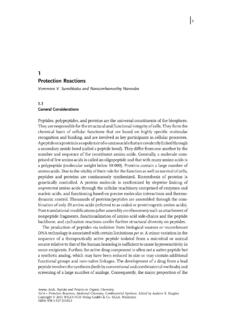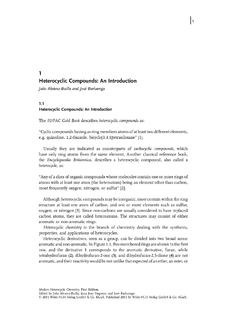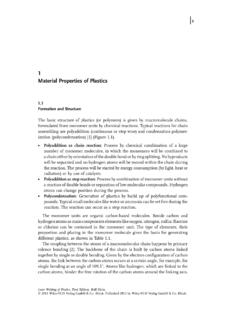Transcription of 1 Introduction: Green Chemistry and Catalysis - Wiley-VCH
1 Is widely acknowledged that there is a growing need for more environmen-tally acceptable processes in the chemical industry. This trend towards what hasbecome known as Green Chemistry [1 9] or Sustainable Technology necessi-tates a paradigm shift from traditional concepts of process efficiency, that focuslargely on chemical yield, to one that assigns economic value to eliminatingwaste at source and avoiding the use of toxic and/or hazardous term Green Chemistry was coined by Anastas [3] of the US Environ-mental protection agency (EPA). In 1993 the EPA officially adopted the name US Green Chemistry Program which has served as a focal point for activitieswithin the united states , such as the Presidential Green Chemistry ChallengeAwards and the annual Green Chemistry and Engineering Conference.
2 Thisdoes not mean that research on Green Chemistry did not exist before the early1990s, merely that it did not have the name. Since the early 1990s both Italyand the united Kingdom have launched major initiatives in Green chemistryand, more recently, the Green and Sustainable Chemistry Network was initiatedin Japan. The inaugural edition of the journal Green Chemistry , sponsored bythe Royal Society of Chemistry , appeared in 1999. Hence, we may conclude thatGreen Chemistry is here to reasonable working definition of Green Chemistry can be formulated as fol-lows [10]: Green Chemistry efficiently utilizes (preferably renewable) raw materials,eliminates waste and avoids the use of toxic and/or hazardous reagents and solventsin the manufacture and application of chemical Anastas has pointed out, the guiding principle is thedesignof environ-mentally benign products and processes (benign by design) [4].
3 This concept isembodied in the 12 Principles of Green Chemistry [1, 4] which can be para-phrased as:1. Waste prevention instead of remediation2. Atom efficiency3. Less hazardous/toxic chemicals4. Safer products by design5. Innocuous solvents and auxiliaries1 Green Chemistry and Arends, R. Sheldon, U. HanefeldCopyright 2007 Wiley-VCH Verlag GmbH & Co. KGaA, WeinheimISBN: 978-3-527-30715-91 Introduction: Green Chemistry and Catalysis6. Energy efficient by design7. Preferably renewable raw materials8. Shorter syntheses (avoid derivatization)9. Catalytic rather than stoichiometric reagents10. Design products for degradation11. Analytical methodologies for pollution prevention12. Inherently safer processesGreen Chemistry addresses the environmental impact of both chemical productsand the processes by which they are produced. In this book we shall be con-cerned only with the latter, product is a given and the goal is to design agreen process for its production.
4 Green Chemistry eliminates waste at source, it is primary pollution prevention rather than waste remediation (end-of-pipesolutions). Prevention is better than cure (the first principle of Green Chemistry ,outlined above).An alternative term, that is currently favored by the chemical industry, is Sus-tainable Technologies. Sustainable development has been defined as [11]:Meet-ing the needs of the present generation without compromising the ability of future gen-erations to meet their own could say that Sustainability is the goal and Green Chemistry is themeans to achieve Factors and Atom EfficiencyTwo useful measures of the potential environmental acceptability of chemicalprocesses are the E factor [12 18], defined as the mass ratio of waste to desiredproduct and the atom efficiency, calculated by dividing the molecular weight ofthe desired product by the sum of the molecular weights of all substances pro-duced in the stoichiometric equation.
5 The sheer magnitude of the waste prob-lem in chemicals manufacture is readily apparent from a consideration of typi-cal E factors in various segments of the chemical industry (Table ).The E factor is the actual amount of waste produced in the process, definedas everything but the desired product. It takes the chemical yield into accountand includes reagents, solvents losses, all process aids and, in principle, evenfuel (although this is often difficult to quantify). There is one exception: wateris generally not included in the E factor. For example, when considering anaqueous waste stream only the inorganic salts and organic compounds con-tained in the water are counted; the water is excluded. Otherwise, this wouldlead to exceptionally high E factors which are not useful for comparing pro-cesses [8].
6 A higher E factor means more waste and, consequently, greater negative envi-ronmental impact. The ideal E factor is zero. Put quite simply, it is kilograms(of raw materials) in, minus kilograms of desired product, divided by kilograms1 Introduction: Green Chemistry and Catalysis2of product out. It can be easily calculated from a knowledge of the number oftons of raw materials purchased and the number of tons of product sold, for aparticular product or a production site or even a whole company. It is perhapssurprising, therefore, that many companies are not aware of the E factors oftheir processes. We hasten to point out, however, that this situation is rapidlychanging and the E factor, or an equivalent thereof (see later), is being widelyadopted in the fine chemicals and pharmaceutical industries (where the need isgreater).
7 We also note that this method of calculation will automatically excludewater used in the process but not water metrics have also been proposed for measuring the environmental ac-ceptability of processes. Hudlicky and coworkers [19], for example, proposed theeffective mass yield (EMY), which is defined as the percentage of product of allthe materials used in its preparation. As proposed, it does not include so-calledenvironmentally benign compounds, such as NaCl, acetic acid, etc. As we shallsee later, this is questionable as the environmental impact of such substances isvery volume-dependent. Constable and coworkers of GlaxoSmithKline [20] pro-posed the use of mass intensity (MI), defined as the total mass used in a pro-cess divided by the mass of product, MI = E factor + 1 and the ideal MI is 1compared with zero for the E factor.
8 These authors also suggest the use of so-called mass productivity which is the reciprocal of the MI and, hence, is effec-tively the same as our opinion none of these alternative metrics appears to offer any particu-lar advantage over the E factor for giving a mental picture of how wasteful aprocess is. Hence, we will use the E factor in further is clear from Table , enormous amounts of waste, comprising primarilyinorganic salts, such as sodium chloride, sodium sulfate and ammonium sul-fate, are formed in the reaction or in subsequent neutralization steps. The E fac-tor increases dramatically on going downstream from bulk to fine chemicalsand pharmaceuticals, partly because production of the latter involves multi-stepsyntheses but also owing to the use of stoichiometric reagents rather than cata-lysts (see later).
9 E Factors and Atom Efficiency3 Table E segmentProduct tonnagea)kg wasteb)/kg productOil refining106 108< chemicals104 106< 1 5 Fine chemicals102 1045 > 50 Pharmaceuticals10 10325 >100a)Typically represents annual production volume of a productat one site (lower end of range) or world-wide (upper end ofrange).b)Defined as everything produced except the desired product(including all inorganic salts, solvent losses, etc.).The atom utilization [13 18], atom efficiency or atom economy concept, firstintroduced by Trost [21, 22], is an extremely useful tool for rapid evaluation ofthe amounts of waste that will be generated by alternative processes. It is calcu-lated by dividing the molecular weight of the product by the sum total of themolecular weights of all substances formed in the stoichiometric equation forthe reaction involved.
10 For example, the atom efficiencies of stoichiometric(CrO3) vs. catalytic (O2) oxidation of a secondary alcohol to the correspondingketone are compared in Fig. contrast to the E factor, it is a theoretical number, it assumes a yield of100% and exactly stoichiometric amounts and disregards substances which donot appear in the stoichiometric equation. A theoretical E factor can be derivedfrom the atom efficiency, an atom efficiency of 40% corresponds to an Efactor of (60/40). In practice, however, the E factor will generally be muchhigher since the yield is not 100% and an excess of reagent(s) is used and sol-vent losses and salt generation during work-up have to be taken into interesting example, to further illustrate the concepts of E factors andatom efficiency is the manufacture of phloroglucinol [23].











